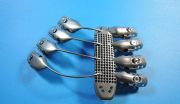(Press-News.org) Genetic mutations called "escape variants" in the deadly Ebola virus appear to block the ability of antibody-based treatments to ward off infection, according to a team of U.S. Army scientists and collaborators. Their findings, published online this week in the journal Cell Reports, have implications for the continued development of therapeutics to treat Ebola virus disease, which has claimed the lives of over 11,000 people in West Africa since last year.
Ebola virus overruns the immune system, thus overwhelming the host's ability to fight off the infection. One strategy for treatment is based on the administration of a "cocktail" of antibodies that have the ability to neutralize the virus and allow the host to mount an effective immune response. One such cocktail, known as MB-003, has demonstrated efficacy in nonhuman primates infected with the virus. MB-003 and ZMAb were early formulations used in proof-of-principle trials that led to the more advanced formulation, ZMapp, currently in development and authorized for compassionate use in the West African Ebola outbreak response.
To understand the reasons for the improvement, investigators at the U.S. Army Medical Research Institute of Infectious Diseases (USAMRIID) Center for Genome Sciences (CGS) examined nonhuman primates that succumbed to Ebola virus despite being treated with MB-003 one or two days post-infection. Viral nucleic acids were isolated from blood samples drawn at multiple time points and were sequenced to provide a description of the viral population. This approach is routinely utilized at USAMRIID to study the development of viral therapeutic resistance against antiviral countermeasures, according to Dr. Gustavo Palacios, director of the center and senior author of the study.
Two clusters of changes in the viral genome were observed in one of the animals that succumbed. Several of those changes corresponded with the viral target sites of two of the cocktail's antibodies, triggering an in-depth molecular analysis of the development and impact of those changes.
"The molecular analysis allowed us to see where the cocktails were inducing changes in the genome, and to link those changes to the treatment failure," said co-first author CPT Jeffrey Kugelman, Ph.D., of USAMRIID. Based on these findings, tissues at selected time-points were used for viral isolation, which finally allowed the "rescue" of the mutated virus.
"When this rescued virus was sequenced, we observed that the clusters of changes had progressed from affecting a small portion of the viral population to becoming mutations--permanent changes in the genome--without disrupting any major viral functions, including the ability to cause infection."
Subsequently, the rescued virus was tested for neutralization against the cocktail and its individual components, demonstrating the inability of the therapeutic to control replication.
"At this point, we knew that the mutations were, in fact, 'escape variants' that were cumulatively responsible for reduced efficacy of the MB-003 therapeutic," Palacios said. "However, we were unsure of the frequency of this type of event."
To help answer that question, the scientists analyzed other independently conducted but similarly designed studies of MB-003.
"We were able to identify, using the same tools, a second animal with a similar pattern of changes," Kugelman noted. "Strikingly, the two animals had four sites in common. This information leads us to believe that these sites are under 'selection pressure' by the therapeutic, meaning that the antibody cocktail binds and promotes elimination of the original virus, while the escape variants continue the infection."
Palacios added that further work is needed to document each individual mutation's effect on each of the three antibodies.
"Our research has already established that a few amino acid changes may be sufficient to erode the binding of multiple antibodies in a cocktail," he said. "It would be very important to determine which changes have a direct impact on binding."
The team's findings highlight the importance of selecting different target domains for each component of the therapeutic cocktail to minimize the potential for viral escape, according to the authors. Two of the antibodies in the MB-003 cocktail target a related region of the Ebola virus glycoprotein, and thus are more susceptible to localized changes affecting multiple antibodies. Furthermore, these findings are important for scientists studying Ebola virus to provide a basis for how quickly the virus can adapt to therapeutics. This rate will be important for predictive models of therapeutic resistance.
Ebola virus causes severe hemorrhagic fever in humans and nonhuman primates with high mortality rates and continues to emerge in new geographic locations, including West Africa, the site of the largest outbreak to date. Over 28,000 confirmed, probable and suspected cases have been reported in Guinea, Liberia and Sierra Leone, with more than 11,000 reported deaths, according to the World Health Organization.
INFORMATION:
The study's authors are Jeffrey R. Kugelman, Johanny Kugelman-Tonos, Jason Ladner, Carolyn M. Keeton, Elyse R. Nagle, Karla Y. Garcia, Jeffrey W. Froude, Ana I. Kuehne, Sina Bavari, John M. Dye, Mariano Sanchez-Lockhart, and Gustavo F. Palacios, USAMRIID; James Pettit, Gene G. Olinger, and Jens H. Kuhn, Integrated Research Facility at Fort Detrick, National Institute of Allergy and Infectious Diseases, National Institutes of Health; and Larry Zeitlin, Mapp Biopharmaceutical, Inc.
USAMRIID's mission is to provide leading-edge medical capabilities to deter and defend against current and emerging biological threat agents. The Institute plays a key role as the lead military medical research laboratory for the Defense Threat Reduction Agency's Joint Science and Technology Office for Chemical and Biological Defense. USAMRIID is a subordinate laboratory of the U.S. Army Medical Research and Materiel Command.
This work was supported by the Defense Threat Reduction Agency.
Reference: Emergence of Ebola Virus Escape Variants in Infected Nonhuman Primates Treated with the MB-003 Antibody Cocktail: Kugelman et al., 2015, Cell Reports 12, 1-10. September 29, 2015.
DOI: http://dx.doi.org/10.1016/j.celrep.2015.08.038
Link to paper online:
http://www.cell.com/cell-reports/pdf/S2211-1247(15)00923-7.pdf
PhD candidate Matt Shultz has discovered the first massive binary star, epsilon Lupi, in which both stars have magnetic fields. A binary star is a star system consisting of two or more stars, orbiting around their common centre of mass.
For the past few years, the BinaMIcS (Binarity and Magnetic Interactions in various classes of Stars) collaboration, formed to study the magnetic properties of close binaries, has been trying to find such an object. They have now discovered one using the Canada-France-Hawaii Telescope.
"The origin of magnetism amongst massive stars is ...
LEXINGTON, Ky. (Sept. 8, 2015) -- A new University of Kentucky study in the journal mBio shows that tissue cysts of the parasite Toxoplasma gondii, long thought to be dormant, are quite active.
Led by Anthony Sinai, professor at the UK College of Medicine, the study has significant implications on the understanding of chronic toxoplasmosis in the brain, a condition suggested to contribute to a range of neurological diseases including schizophrenia in humans, and the modulation of behavior in rodents.
Toxoplasmosis can be acquired from the droppings of infected cats ...
Using metallic osmium (Os) in experimentation, an international group of researchers have demonstrated that ultra-high pressures cause core electrons to interplay, which results in experimentally observed anomalies in the compression behavior of the material.
Os is one of Earth's most exceptional elemental materials, possessing the highest known density at ambient pressure, one of the highest cohesive energies and melting temperatures, and an incompressibility that is almost comparable to that of diamond.
Researchers believe that the ability to affect core electrons ...
Open source lab equipment is the focus of a new study, published in Science and Public Policy. Joshua Pearce, an associate professor of materials science and engineering as well as electrical and computer engineering at Michigan Tech, led the research. Pearce proposes that instead of spending millions of dollars every year replacing quickly obsolescent equipment, that money could be redirected to developing open source tools that are "upgradeable and transformable--they will be continuously updated" using digital manufacturing techniques such as 3-D printing.
The benefits ...
The politics of climate change are often depicted as a simple battle, between environmentalists and particular industries, over government policy. That's not wrong, but it's only a rough sketch of the matter. Now a paper co-authored by MIT economist Christopher Knittel fills in some important details of the picture, revealing an essential mechanism that underlies the politics of the climate battle.
Specifically, as Knittel and his colleagues demonstrate, at least one climate policy enacted by Congress -- on transportation fuels -- contains a crucial asymmetry: It imposes ...
The aging process is associated with declines in brain function, including memory and how fast our brain processes information, yet previous research has found that higher levels of cardiorespiratory fitness in older adults leads to better executive function in the brain, which helps with reasoning and problem solving. Higher cardiorespiratory fitness levels have also been found to increase brain volume in key brain regions.
A new study from a team at the Beckman Institute for Advanced Science and Technology at the University of Illinois reveals the connection between ...
UPTON, NY--In the Daya Bay region of China, about 55 kilometers northeast of Hong Kong, a research project is underway to study ghostlike, elusive particles called neutrinos. Today, the international Daya Bay Collaboration announces new findings on the measurements of neutrinos, paving the way forward for further neutrino research, and confirming that the Daya Bay neutrino experiment continues to be one to watch.
The latest findings involve measurements that track the way neutrinos change types or flavors as they move, a characteristic called neutrino oscillation. By ...
VIB and UGent scientists have developed a new method which allows them to predict the final size of a plant while it is still a seedling. Thanks to this method, which is based on the knowledge that a set of genes is associated with the final size of a leaf, scientists will be able to significantly accelerate plant breeding programs. The VIB/UGent scientists were able to identify this set of genes through advanced and highly detailed analyses. Expression analysis of specific genes will help breeders select the most useful crossing products at a very early stage.
Smart ...
Tyrosine kinase 2 (Tyk2) is an enzyme involved in intracellular signalling and has an important role in activating the immune system. But enzymatically active Tyk2 can also promote excessive immune reactions and growth of certain cancer types.
Since several years, scientists are developing substances to specifically inhibit the kinase activity of Tyk2 for the treatment of inflammatory diseases and for potential use in cancer therapy. However, complications may occur: Tyk2 crucially contributes to the maturation and activation of natural killer (NK) cells. NK cells form ...
After being diagnosed with a chest wall sarcoma, a 54-year-old Spanish man's surgical team made the decision to remove his sternum and a portion of his rib cage and replace it with an implant.
The implant was designed and manufactured by medical device company, Anatomics, who utilised the CSIRO's 3D printing facility, Lab 22 in Melbourne, Australia.
The surgical team, Dr José Aranda, Dr Marcelo Jimene and Dr Gonzalo Varela from Salamanca University Hospital, knew the surgery would be difficult due to the complicated geometries involved in the chest cavity.
The ...


